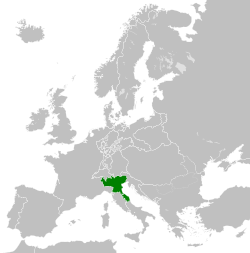Kingdom of Italy | |
|---|---|
| 1805–1814 | |
 The Kingdom of Italy in 1812 | |
| Status | Client state of the French Empire |
| Capital | Milan |
| Common languages | |
| Religion | Catholic |
| Demonym(s) | Italian |
| Government | Unitary absolute monarchy |
| King | |
• 1805–1814 | Napoleon I |
| Viceroy | |
• 1805–1814 | Eugène de Beauharnais |
| Legislature | Consultant Senate |
| Historical era | Napoleonic Wars |
| 17 March 1805 | |
| 19 March 1805 | |
• Coronation of Napoleon I | 23 May 1805 |
| 26 December 1805 | |
| 8 February 1814 | |
| 11 April 1814 | |
| 30 May 1814 | |
| Currency | Italian lira |
| History of Italy |
|---|
 |
|
|
The Kingdom of Italy (Italian: Regno d'Italia; French: Royaume d'Italie) was a kingdom in Northern Italy (formerly the Italian Republic) that was a client state of Napoleon's French Empire. It was fully influenced by revolutionary France and ended with Napoleon's defeat and fall. Its government was assumed by Napoleon as King of Italy and the viceroyalty delegated to his stepson Eugène de Beauharnais. It covered some of Piedmont and the modern regions of Lombardy, Veneto, Emilia-Romagna, Friuli-Venezia Giulia, Trentino, South Tyrol, and Marche. Napoleon I also ruled the rest of northern and central Italy in the form of Nice, Aosta, Piedmont, Liguria, Tuscany, Umbria, and Lazio, but directly as part of the French Empire (as departments), rather than as part of a vassal state.

